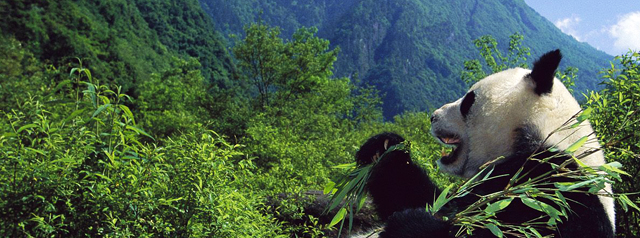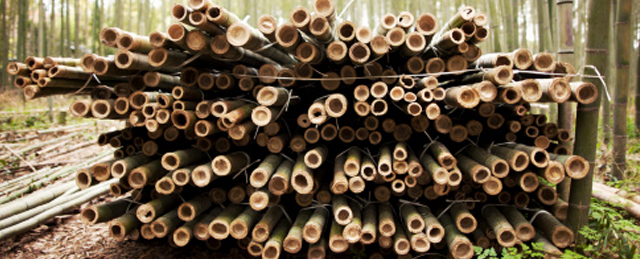In our last post, we looked at the pure awesomeness of Hemp. To not be outdone, today we are focusing on the equally awesome power and versatility of Bamboo. Yes pandas eat it, but so do humans, and it can me be made into apparel, furniture, flooring, building materials, and even used as an alternative to metal in some cases. How can a plant be so edible, and so hard, and so ridiculously comfortably soft? Magic of course! Here are some of the magical and amazing properties (and uses) of bamboo:
First, did you know that bamboo is the fastest growing plant on earth? It grows two inches per hour…and bamboo grows everywhere! It can grow at sea level all the way up to 12,000 feet, where the air is thinner but the views are great (which is why perhaps it makes the effort). There are more than 1,500 species of bamboo and it grows on every continent. It also likes wet and dry climates; bamboo can handle from 30-250 inches of annual rainfall, which is more than we can say for ourselves. The only places it doesn't grow are the North and South Poles, and we don't blame it. It's not so pretty out there, and a little chilly.
Bamboo fabric is one of the most economical and ecological products in the world today. Due to the nature in which it grows, bamboo requires only a fraction of the time and resources spent on producing cotton. 100% biodegradable, the fibers used to make bamboo fabric don't need to be sprayed with chemical additives of any sort. There is also less water wasted for irrigation for bamboo, and there is very little surface runoff from chemicals that could be sprayed on the plants to keep them healthy, as these chemicals aren't needed. Bamboo also grows amazingly fast at the rate of two inches per hour! You can sit there and literally watch bamboo grow.
Another reason to love bamboo: It grows an amazing root system. Those little feelers reach out into the soil to help prevent erosion. Imagine a net under the soil, holding everything in place. When heavy rains pour down, the roots are like a mother with a newborn; they don't let go. In places where clear-cutting has been practiced, there are no strong root systems and the soil is washed away-causing catastrophe and landslides. In fact, bamboo keeps twice as much water in the watershed than commercial trees, often eliminating the need for irrigation and sprinkler systems. Bamboo is also a live saver in areas that have been ravaged by deforestation.
Deforestation starts a vicious circle of drought and environmental decline. Burning wood releases the carbon stored inside, and deforestation accounts for at least a fifth of all carbon emissions globally. As tree cover vanishes, the land dries out and the soil erodes and becomes barren — a major reason for Ethiopia’s periodic famines.
There are hundreds of examples demonstrating the usefulness and versatility of bamboo. These are just a few:
• Bamboo fabric feels softer than the most refined cotton.
• Bamboo fabric tests as well as every other material for color fastness when washing and wear over time.
• The fabrics made of bamboo appear to look like other materials which are more expensive, such as silk.
• Bamboo requires very little to no pesticides, an attribute which scientists have discovered is from an anti-bacterial bio-agent called bamboo-kun. Bamboo-kun makes the fabric resistant to bacteria, and scientists have done tests to show that a large portion of bacteria that naturally incubates on bamboo fabric doesn't survive.
• Bamboo fabric wicks away moisture, keeping the skin cool and dry. These insulating characteristics also make bamboo fabric warm in colder months.
• Thomas Edison used carbonized bamboo filament in his experiment with the light bulb, which is still burning in the Smithsonian Museum to this very day.
• Tabasheer (the hardened secretion from bamboo) treats asthma, coughs, and many other ailments.
• Due to the lightweight and favorable elastic properties of bamboo, buildings made from it are very good at resisting earthquakes. All 30 houses in the epicenter of a 7.6 magnitude earthquake survived without any damage in Costa Rica..
• Studies show that processing of bamboo requires only 1/8th the energy for processing of concrete and 1/3rd of that of wood to create a building material of the same capacity. In comparison to steel, bamboo needs only 1/50 of the energy for processing.
Amazing right? We think so too. In addition to all of the amazing facts above (like hemp) bamboo has been spun into some of the awesome shirts you can find here at Herb & Bamboo.
Thank you for your continued support,
~Herb & Bamboo
www.facebook.com/herbandbamboo
www.instagram.com/herbandbamboo
www.twitter.com/herbandbamboo
#EnjoyYourself


